
Types of Plates
When it comes to choosing plates for your commercial establishment, it's important to consider the different types available. The right type of plate can enhance the presentation of your food and contribute to a positive dining experience for your customers. Whether you're choosing plates for your restaurant or next catered event, use this guide to determine which type of plate and plate size you need based on what you're serving.
Shop All China Plates
Use the following links to jump to the different plates that interest you most:
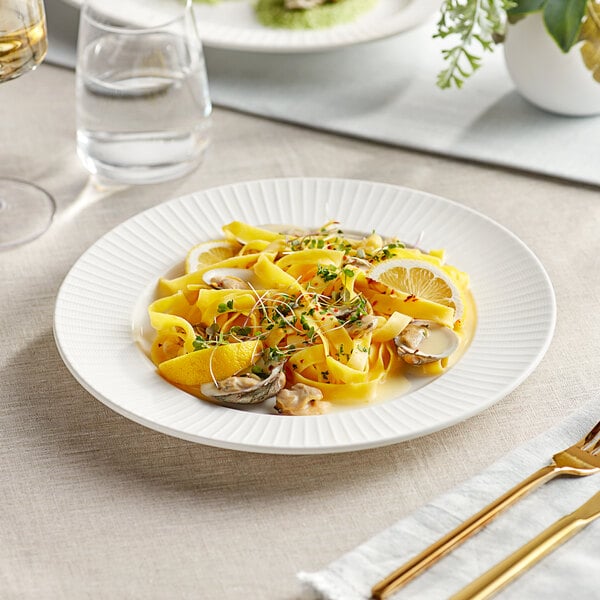
As the name suggests, dinner plates are used during dinner service to host the entree. These plates are larger compared to other types of plates, making them suitable for serving main courses and larger portions of food.
- Accommodate a complete meal, including the main course, side dishes, and any accompanying sauces or gravies
- Often feature a wide rim for easy handling when serving food
- A flat and wide surface area provides enough space to arrange different food items without overlapping
Dinner Plate Size
Dinner plates range from 10" to 12" in diameter, with the standard dinner plate size being 10 1/2". This size provides enough space for the main course and any accompanying sides, without overwhelming the plate. Additionally, the larger size of dinner plates allows for creative plating techniques, enabling chefs to elevate the visual appeal of their dishes.

A dessert plate, also known as a dessert dish or a dessert saucer, is a small-sized plate specifically designed for serving desserts. They provide a perfect portion size for individual desserts, ensuring that each guest can enjoy their serving without feeling overwhelmed.
- Typically served towards the end of a meal, after the main course has been enjoyed
- Ideal for serving cakes, pastries, pies, and tarts
- Commonly used for serving appetizers, pastries, and side dishes
Dessert Plate Size
Dessert plates are smaller in size compared to dinner plates, as they are designed for individual servings of desserts. The standard size of a dessert plate is around 6" to 8" in diameter. Oftentimes, dessert plates and appetizer plates can be used interchangeably to cut down on costs in your restaurant.
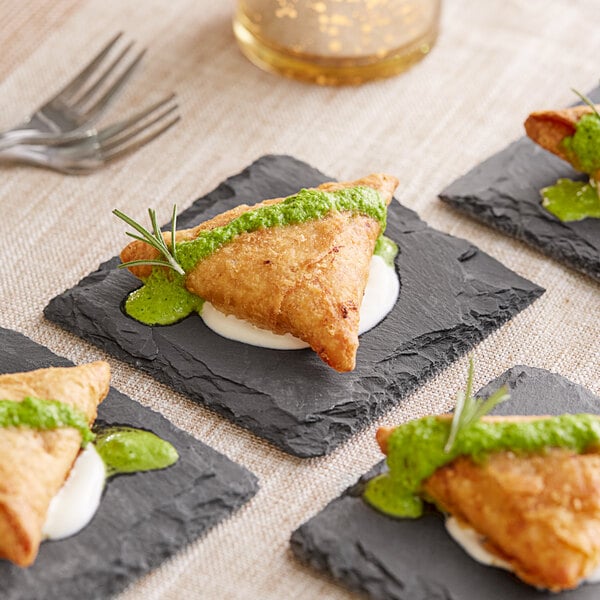
A must for any foodservice establishment with an appetizer menu, appetizer plates are primarily used for serving a wide range of appetizers and hors d'oeuvres. Because they are used to serve a variety of foods, they are the most versatile in shape, coming in both classic and irregular forms. They are commonly used in restaurants, catering events, and banquet halls, allowing guests to sample different flavors and textures.
- Typically served at the beginning of a meal or during cocktail hours
- Allow guests to enjoy a variety of small bites before the main course
- Commonly used for serving small desserts, pastries, and sides
Appetizer Plate Size
Also known as a small plate or a tasting plate, is a compact dish that typically measures around 4" to 7" in diameter. The size of the plate you choose will depend on the type of appetizer you are serving and the desired presentation. Smaller plates, around 4" to 5", are ideal for bite-sized appetizers, while larger plates, around 6" to 7", can accommodate slightly larger portions or more intricate presentations.
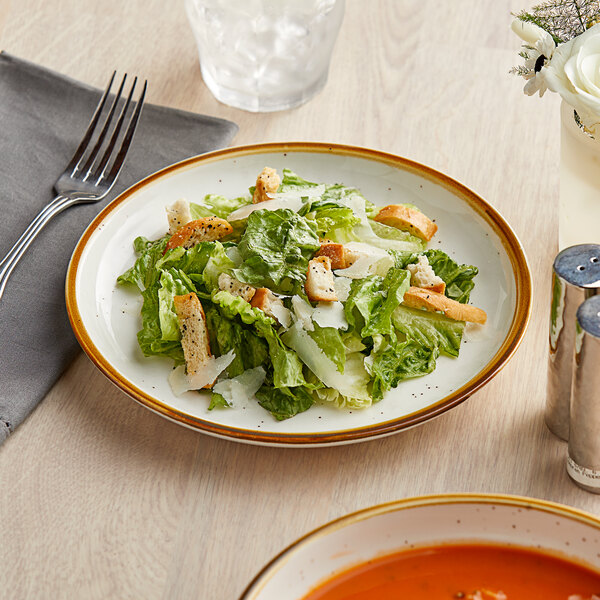
As their name implies, salad plates are primarily used for serving salads before the main course. These plates are smaller in size compared to dinner plates, making them perfect for individual servings of fresh greens, vegetables, fruits, and other salad ingredients.
- Typically served before the main course
- Feature a raised rim around the edge to prevent food from spilling or sliding off the plate
- Suitable for serving appetizers, desserts, small sandwiches, and side dishes
Salad Plate Size
Salad plates generally have a diameter ranging from 7" to 8 1/2". This size is perfect for individual servings of salads and appetizers. The compact size of salad plates allows for easy handling and portion control, making them ideal for plated salads or as part of a larger table setting.
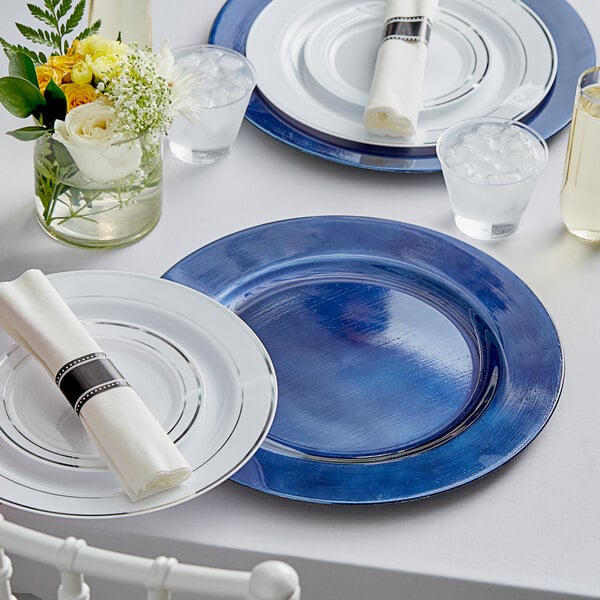
A charger plate, also known as a service plate or underplate, is a decorative, larger-sized plate that is placed underneath the dinner plate. Charger plates are used to add elegance and style to formal dining settings, such as weddings, banquets, upscale restaurants, and other special events.
- Enhance the visual appeal of the table setting
- Not meant to be used for serving food directly; many are not made with food-safe materials
- Placed on the table before guests are seated and removed before the dessert course
Charger Plate Size
The standard charger plate size is 13" in diameter. This larger size allows them to accommodate the standard dinner plate comfortably. It is important to consider the size of the charger plate in relation to the rest of the table setting to ensure a balanced and visually pleasing arrangement. Remember that charger plates are not meant to be used for serving food directly, so their size should be chosen based on their decorative purpose and compatibility with the rest of the dinnerware.
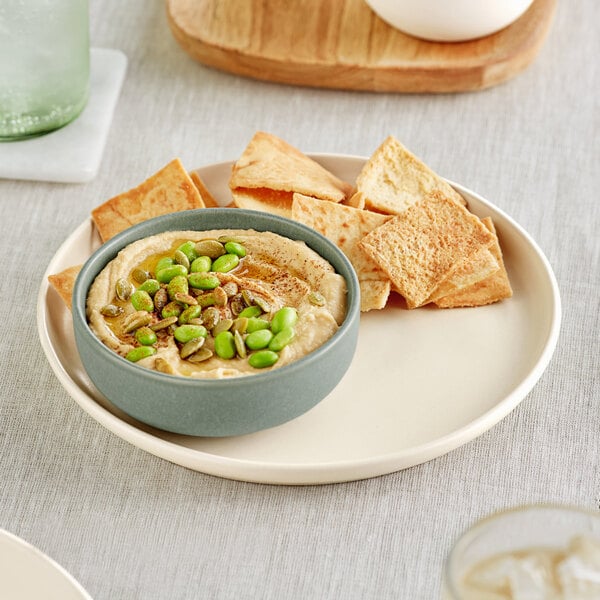
Slightly smaller than dinner plates, luncheon plates are commonly used for serving sandwiches, wraps, smaller portions of entrees, and salads. However, they can also be used during brunches, afternoon teas, and other light meal occasions. Their size also makes them ideal for presenting individual servings of appetizers during cocktail parties, buffets, or other social events.
- Accommodate lunchtime portions
- Ideal for formal or semi-formal events
- Commonly used for breakfast and brunch plates
Luncheon Plate Size
Luncheon plates are slightly smaller in size compared to dinner plates, measuring 9" in diameter. The main difference between a luncheon plate and a dinner plate lies in their size. Dinner plates are larger, usually measuring around 9 to 11 inches in diameter, and are intended for serving main courses. On the other hand, luncheon plates are smaller and are more suitable for lighter meals, appetizers, salads, and desserts.
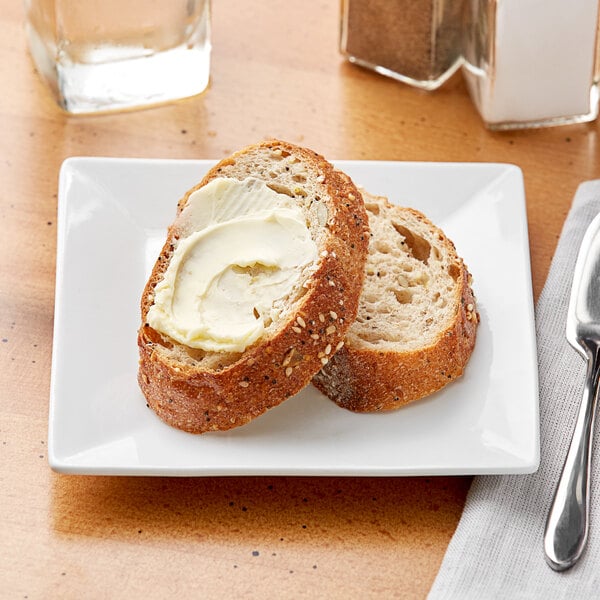
Sometimes referred to as simply a bread plate, a bread and butter plate is a small-sized plate typically used for serving bread, butter, or small appetizers. The plates are commonly used in fine dining restaurants, banquet halls, catering events, hotels, and other establishments that offer complementary bread baskets or dinner rolls.
- Typically served before the main course or in conjunction with other dinnerware, such as dinner plates, salad plates, and soup bowls
- Ideal for upscale establishments and catered events
- Suitable for serving small appetizers and pastries
Bread and Butter Plate Size
The size of a bread and butter plate typically ranges from 6" to 7" in diameter. This compact size allows for easy handling and placement on the table, while still providing enough space for bread slices or small appetizers. The smaller size also helps to control portion sizes and prevent food waste.
When selecting plates for your dinnerware collection, consider various factors such as durability, aesthetic value, and budget. Plates come in different shapes, colors, and patterns, allowing you to create a cohesive presentation or an attractive mix-and-match tablescape.
Plate Materials
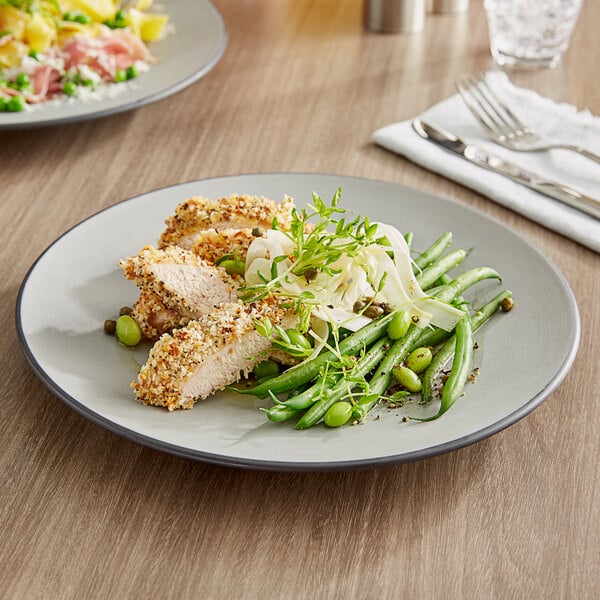
Material is a crucial factor to consider when selecting plates. Ultimately, the best plate material for your restaurant depends on your specific needs, budget, and the dining experience you aim to create. Here are the most common plate materials used in restaurants:
- China: A classic choice often used in fine dining establishments, china plates are known for their durability and refined look. China dinnerware is made from clay and fired at high temperatures, resulting in a delicate appearance with excellent heat retention.
- Porcelain: Suitable for a wide range of restaurant types, from casual to fine dining, porcelain plates strike a balance between elegance and practicality. They are fired at high temperatures, making them non-porous and resistant to stains and chips.
- Bone China: Considered the finest and most luxurious option among ceramic dinnerware, bone china plates contain bone ash, which gives it a distinct translucent quality and lightweight feel. Despite its delicate appearance, bone china is surprisingly strong and chip resistant. These plates are best for high-end, formal dining establishments that want to exude sophistication.
- Stoneware: Great for casual and family-oriented restaurants with a cozy atmosphere, stoneware plates provide a more rustic and earthy look. Fired at lower temperatures, which can result in a more textured and glazed finish, stoneware dinnerware is resistant to chipping and has a thicker, heavier feel than traditional china.
- Melamine: Mimicking the look of china without the associated cost, melamine plates are lightweight, break-resistant, and dishwasher safe. They are a practical choice for high-volume operations, outdoor patios, and cafeterias. While melamine dinnerware offers unmatched durability, they are not microwave safe.
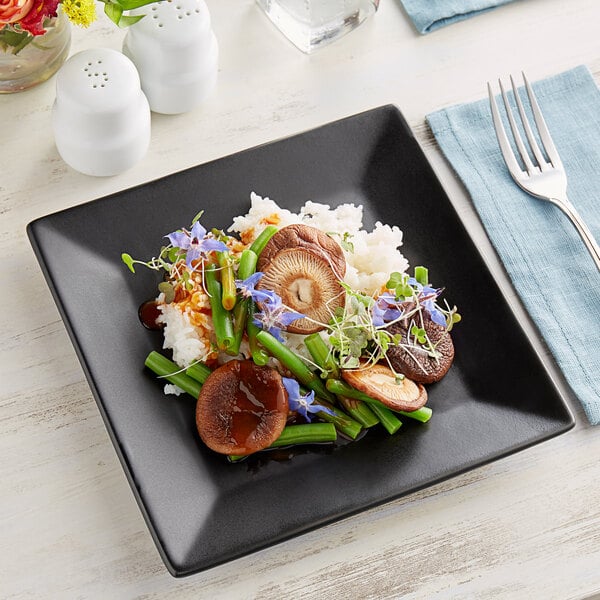
Plate Shapes
Choosing the best plate shape for your restaurant involves considering several factors, including your restaurant's style, the type of cuisine you serve, and the desired presentation. Here's a brief overview of each plate shape:
- Round Plates: Round plates are the most traditional and versatile choice. They work well for various types of cuisine and provide a classic, balanced presentation.
- Square Plates: Square plates offer a modern and contemporary look. They are great for dishes with clean lines and artistic plating.
- Coupe Plates: Coupe plates are round plates with a slight upward curve at the edges, giving them a contemporary and minimalistic appearance. They work well for foods with saucy or artistic presentations but may not contain liquids as effectively as plates with a defined rim.
- Triangle Plates: Triangle plates are a bold and eye-catching choice. They add a unique aesthetic and can make a statement in your restaurant. They are suitable for artistic presentations and unconventional plating styles.
Plate Colors
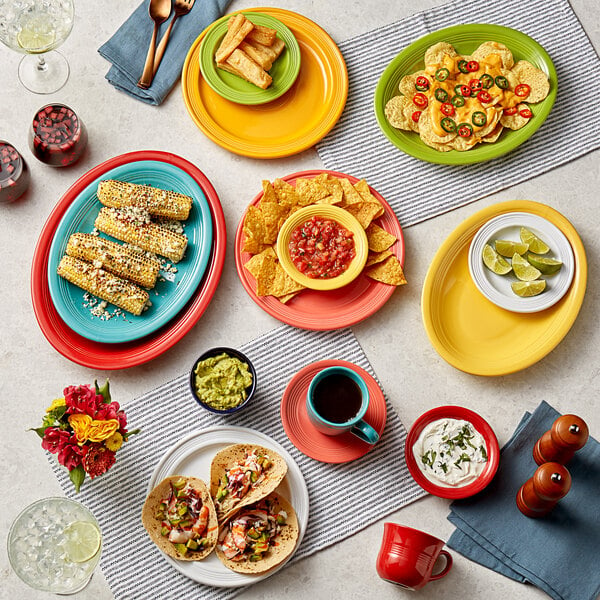
Like the interior colors of your restaurant, the plate colors also influence your customers' dining experience. We'll go over how some of the most common plate colors can impact appetite and plating presentation:
- White: White plates are often associated with cleanliness and purity. They can enhance the visual appeal of colorful foods and red pasta dishes, making them stand out. They are widely considered neutral and versatile, suitable for various cuisines.
- Black: Black plates create a high-contrast background, bringing visual interest to colorful and neutral foods. They can add an element of sophistication and elegance to the presentation. However, black plates may not be ideal for very dark or heavy dishes.
- Brown: Brown plates can evoke a rustic and earthy feeling. They work well with foods that have warm or natural tones, such as roasted meats and vegetables.
- Red: Red is a bright, energetic color that stimulates the appetite. It can bring a pop to neutral foods like tortillas, chicken, and mashed potatoes.
- Yellow: Yellow is another energetic, warm color that can stimulate the appetite. Yellow plates are great for pairing with green foods like salads, pesto dishes, and avocado toast.
- Green: Green plates can enhance the perception of freshness and healthiness. They pair nicely with salads, vegetable-based dishes, and egg dishes.
- Blue: Blue plates are relatively uncommon in dining settings because blue is a color less commonly found in natural foods. However, they can work well with seafood dishes and enhance the visual appeal of yellow and orange foods like eggs and curries since blue is opposite from them on the color wheel.
The "best" color plate to eat off depends on various factors, including the type of food you're serving and your dining room's ambiance. White plates are a safe choice for most dishes because they provide a clean and neutral backdrop. However, using contrasting colors that complement the food's appearance can also enhance the dining experience. Ultimately, it's essential to consider the overall presentation, cultural context, and the emotional response you want to evoke when choosing plate colors for a specific meal.
Related Resources

June 2024 WebstaurantStore Coupon Code
Summer is almost here, and to celebrate Webstaurantstore is offering a variety of amazing monthly deals! In June, you'll discover incredible prices on glassware, flavoring syrups, disposable packaging supplies and much more! Take a look at our selection of sale items below and don't forget to enter the code SUMMERSALE at checkout to enjoy savings of up to 25%! We're also excited to introduce the new Webstaurant Rewards® Visa Business Card ! Sign up for a new card today and start earning rewards on every WebstaurantStore purchase. Use Coupon Code: SUMMERSALE DaVinci Gourmet Classic Passion Fruit Flavoring / Fruit Syrup 750 mL reg. $6.89 Each $5.86 Shop Now Monin Hydration Boost Syrup 1 Liter reg. $12.49 Each $11.24 Shop Now Fanale Strawberry
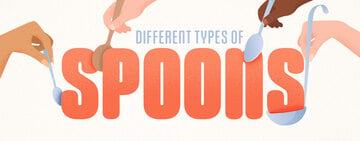
Types of Spoons
Regardless of what's on your menu , you probably utilize a spoon at some point in the preparation process. Whether used for stirring coffee, making spaghetti, or ladling soup, spoons are a kitchen and dining staple with a wide range of uses. Each type of spoon has a specific purpose, including measuring, stirring, eating particular foods, and cooking. As you restock your utensils or plan what you need for your brand-new restaurant , use this guide to learn more about the different types of spoons for cooking, serving, eating, measuring, and other special tasks. Shop All Spoons Use the following links to learn more about spoons: Types of Cooking Spoons Types of Serving Spoons Types of Spoons for Eating Types of Measuring Spoons Types of Spec
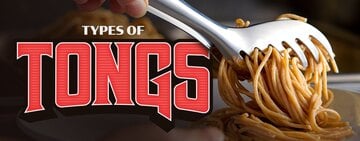
Types of Tongs
Tongs are one of the most useful and versatile cooking tools you will find in a kitchen. They are used for a variety of tasks from flipping burgers and grilled meats to plating delicate garnishes for a unique presentation . In this guide, we'll go over the types of tongs that are designed to help streamline specific tasks so you can make sure you're using the best tong for the job. Shop All Kitchen Tongs
- Topics 1364
- Industrial 55
- Troubleshooting Guides 21
- Restaurant Management 129
- Bar Management 57
- Catering Tips 37
- Bakery Management 42
- Food Trucks & Concessions 49
- Advertising & Marketing 37
- Eco-Friendly Tips 11
- Facility Layout & Design 42
- Coffee Shop Tips 29
- Installation & Maintenance 52
- Janitorial & Pest Control 30
- Safety & Sanitation 88
- Startup Tips 104
- Menu Design 10
- Kitchen & Cooking Tips 84
- Hospitality Management 24
- Pizza & Sandwich Shop Tips 36
- Smallwares 37
- Food Prep 90
- Tabletop Items 17
- Disposables 22
- Calculators & Tools 6
- Consumables 52
- Warewashing & Laundry 19
- Cooking Equipment 92
- Food Storage & Refrigeration 51
- Beverage Equipment 35
- Office Supplies 6


